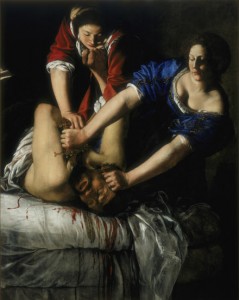Artemisia, Power, Glory and Passion – review
Musée Maillol’s exhibition of 17th-century female Italian painter Artemisia Gentileschi leaves mysteries unsolved.

Pathos-loaded ... detail from Artemisia Gentileschi's Judith and Holofernes. Click on the image for a larger version. Photograph: Museo Nazionale di Capodimontem, Naples/Alinari/Rex Features
Artemisia Gentileschi (1593-1654) suffered a cruel setback in her early life. As a young woman she worked for her father Orazio Gentileschi de Lomis, a minor painter. In May 1611 she was raped by Agostino Tassi, also employed in the studio. The culprit promised to marry her, but in March the following year Orazio denounced him. The young man was sentenced to five years as a galley slave, but managed to escape punishment. Two days later Gentileschi married the Florentine Pierantonio Stiattesi, who accepted what was then seen as a taint on his honour.
Her story now took a more amorous turn, and Gentileschi engaged in a life of great liberty, taking as her lover a Florentine noble, Francesco Maria Maringhi. Ultimately she flourished as an artist, working in Florence, Rome, Venice and Naples, at the head of her own studio. The public registry contains records of countless debts and long disputes, which did not hinder a steady stream of paintings.
Almost in spite of this story, Artemisia, the Power, the Glory and the Passions of a Woman Painter at the Musée Maillol in Paris (until 15 July) focuses on issues of dating and attribution. It largely overlooks her position as a woman painter in 17th-century Italy.
The exhibition starts with Gentileschi’s Neapolitan period, when she was at the peak of her fame, rather than her formative days in Rome, when the assault occurred. Unfortunately it is difficult to clearly identify the artist’s particular style in the Naples paintings, which are often in fairly poor condition, having been disregarded by curators for years. Concentrating on the ones that are signed and can be dated approximately, we soon see that Gentileschi was changeable. Much as all her contemporaries, she was influenced by Caravaggio, with high-contrast lighting effects, flesh bathed in light set off by dark shadows, contorted features, violent gestures. But this manner, which suits pathos-loaded subjects such as Judith beheading Holofernes, or Suzanne and the Elders, is not right for a Madonna and Child, or her allegories of rhetoric and history. The chiaroscuro is gentler, the colours more restrained, in a style closer to that of Guido Reni or Domenico Zampieri. Add to this a hard, linear Danae and an affected Cleopatra, and identifying an overall style for Gentileschi becomes very difficult. The curators should be congratulated on presenting the problem clearly, without attempting to impose their own particular interpretation.
Which leaves psychology. Gentileschi seems to have had a particular liking for two types of scene: on the one hand, voyeuristic pictures in which bodies are revealed – Suzanne, Bathsheba, Diana; on the other, narratives that explicitly link sexuality to pain – Judith decapitating Holofernes, Yael killing Sisera by hammering a nail into his head, a naked Cleopatra bitten by a snake.
It is tempting to see a connection with Gentileschi’s rape, which she repeatedly rehearsed in sacred and profane stories. But it is equally plausible to suppose that her patrons had a say on subject matter, particularly as she was not the only contemporary painter exploring such themes. So all in all Gentileschi remains a mystery.
This article originally appeared in Le Monde.
By Philippe Dagen
Source: http://www.guardian.co.uk